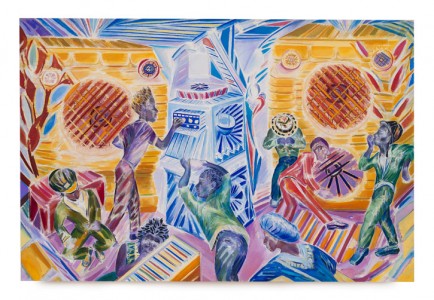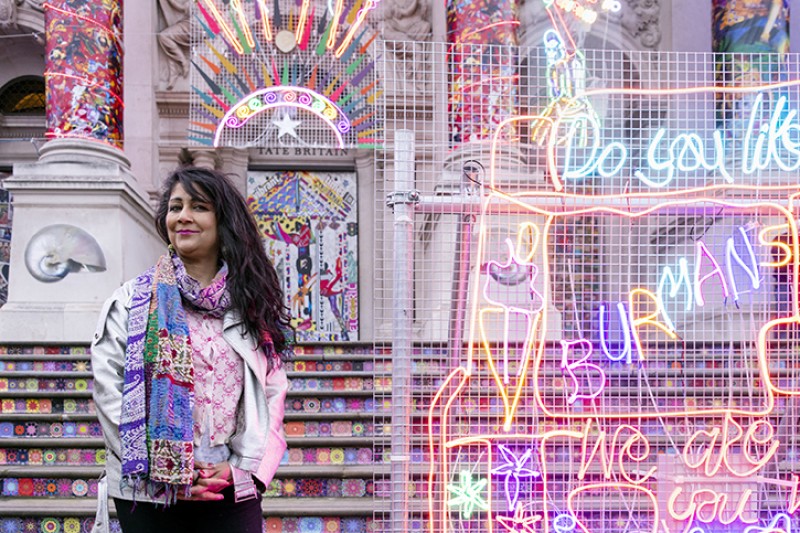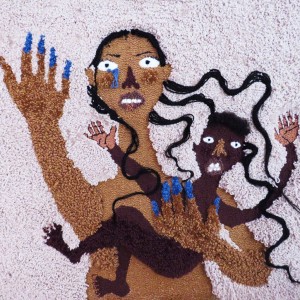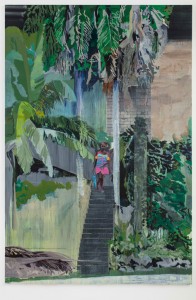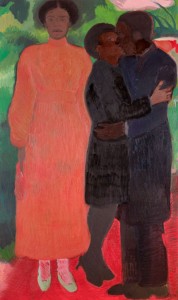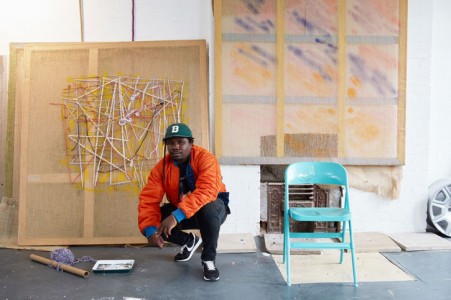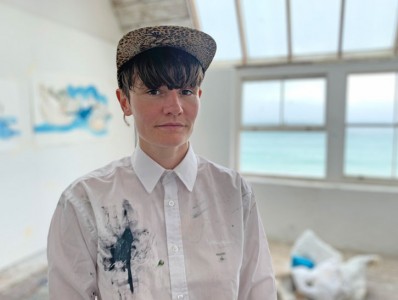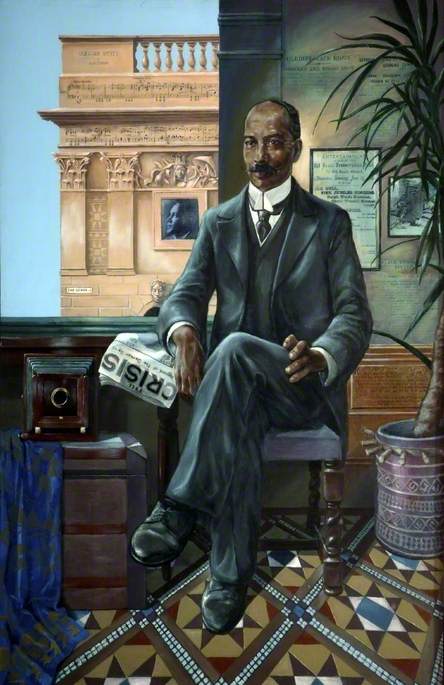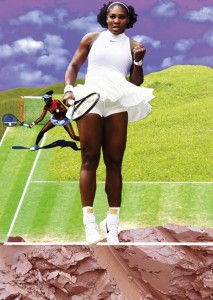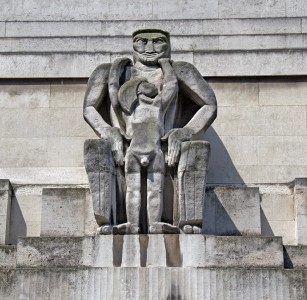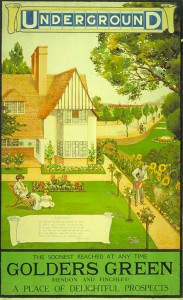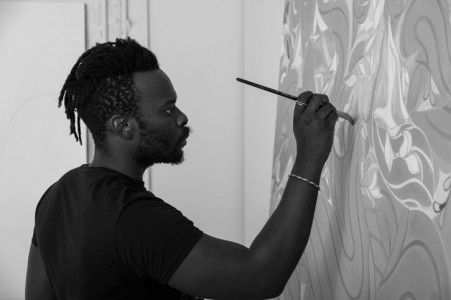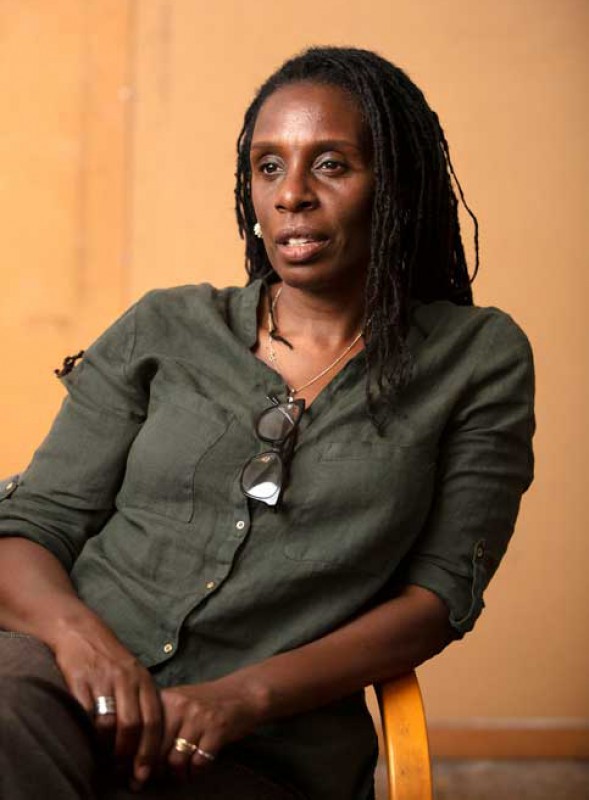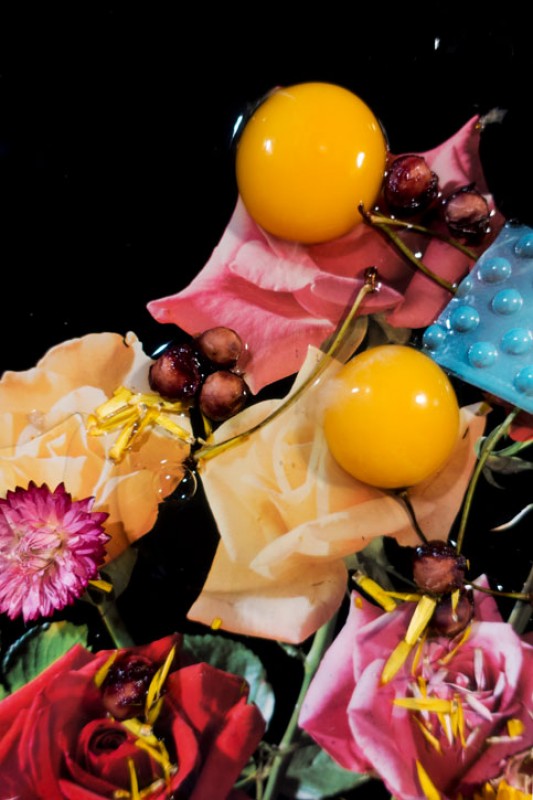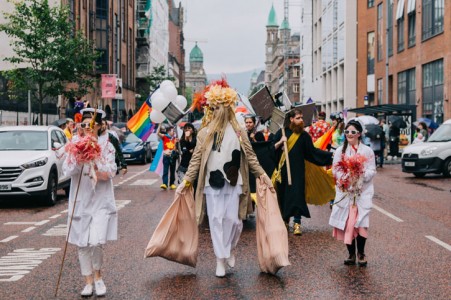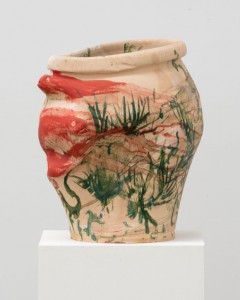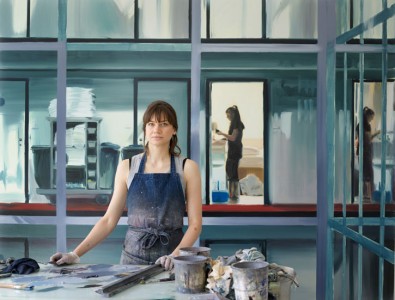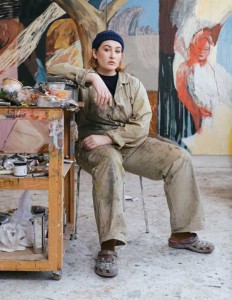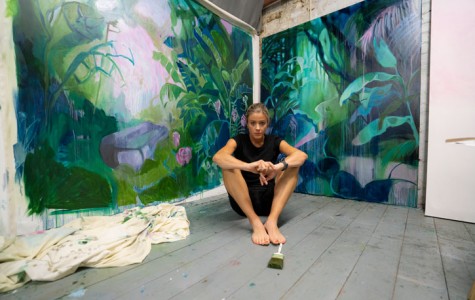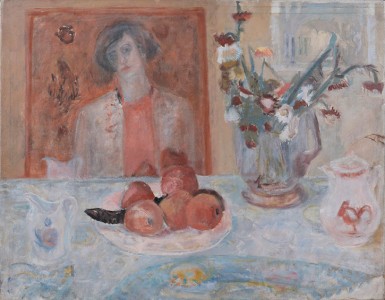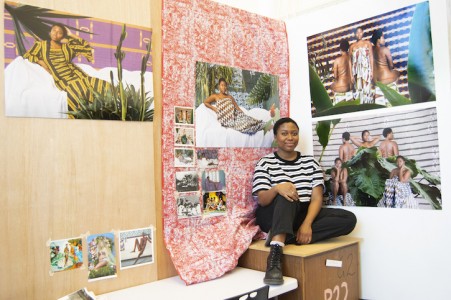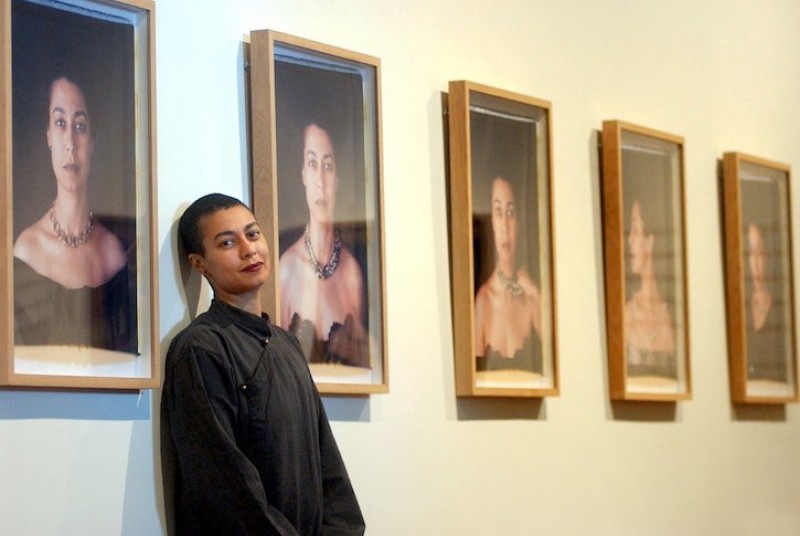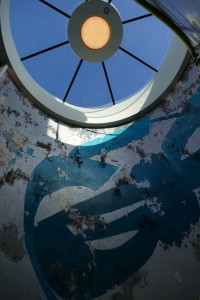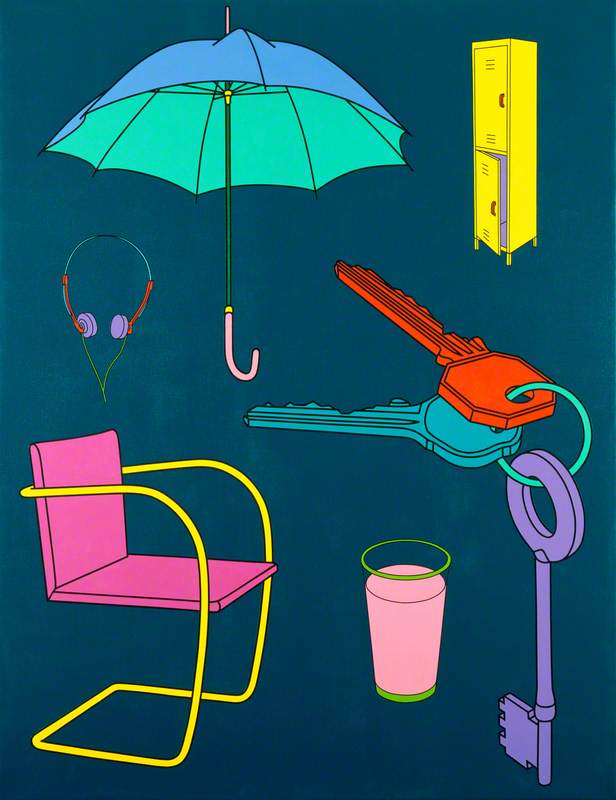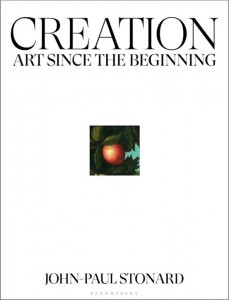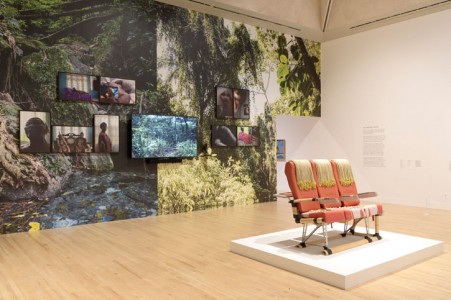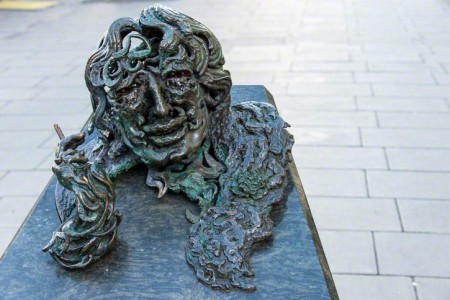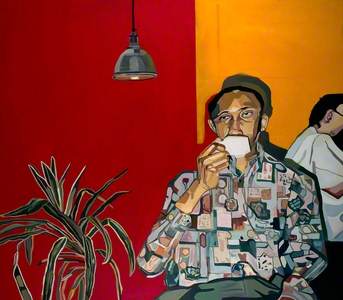In the series 'Seven questions with...' Art UK speaks to some of the most exciting emerging and established artists working today.
Coming to prominence soon after graduating from Newcastle University in 2017, Joy Labinjo is known for her colourful, large-scale paintings rooted in her British-Nigerian heritage and her experiences as a Black woman living in the UK.
'We came to a country that we helped to build'
2021 by Joy Labinjo (b.1994) 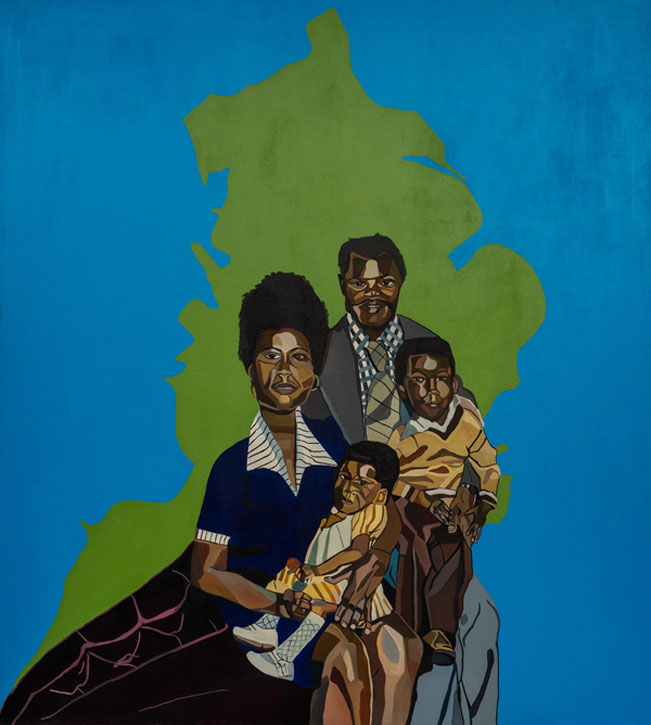
Early on in her career, she made a conscious decision to elevate the Black figure, and in particular, the Black family. Disappointed with the lack of positive Black subjects in art history, she began producing vibrant portraits based on images of family members and their friends. Filled with vivid colours and lively patterns, they portray everyday scenes of domestic family life, often presenting figures in imagined interiors that lend the scenes a timeless quality.
Joy's paintings initially drew inspiration from old photograph albums, found images and historical archives, though as her art has become overtly political and context-specific she has looked increasingly to the internet. Scouring Instagram and Google Images for source material, she collages her compositions together on the computer, a technique that gives her works a lively visual vocabulary with a distinctive flattened perspective.
5 more minutes
2021, mural at Brixton Underground station by Joy Labinjo (b.1994) 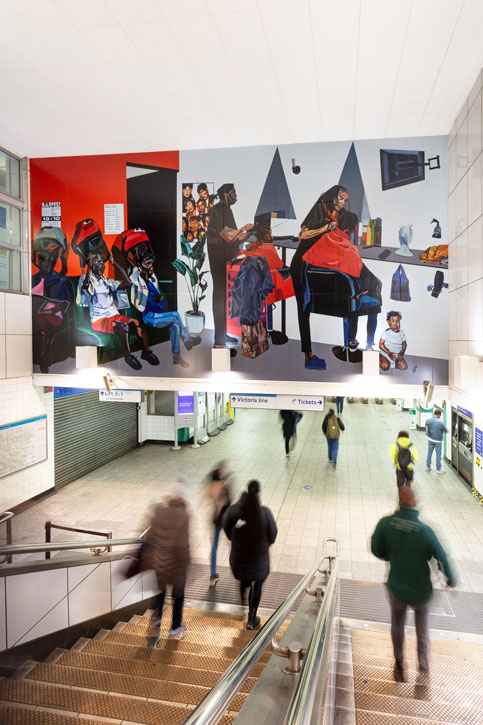
Her new commission for Art on the Underground was recently unveiled at Brixton Underground station. Titled 5 more minutes, the large-scale artwork depicts the interior of an imagined hair salon and is based on found images and memories of the spaces she has visited throughout her life. In Brixton, hair salons are integral to local Black communities and Joy's painting points to the significance of these spaces in wider Black British female culture. I spoke to her about the commission, her approach to painting, and her recent shift in subject matter.
David Trigg: Your commission for Art on the Underground is the most recent in a series that has seen Helen Johnson, Denzil Forrester, Aliza Nisenbaum and Njideka Akunyili Crosby all make work for Brixton Underground station. How did you approach the project?
Joy Labinjo: I felt a lot of responsibility because I was in the company of great artists. I'm also the youngest so far and I didn't want to disappoint. I've been working in Brixton for several years, so I have a good understanding of the community and wanted to do something that reflected it. I've seen all of the previous Art of the Underground commissions at the station, so I understood the space I was working with, but it took me a while to get to the subject of the hair salon.
5 more minutes
2021, mural at Brixton Underground station by Joy Labinjo (b.1994) 
I knew that I wanted to make something that was rooted in the community and, after considering a few different subjects, I chose a salon because it reflected what first comes to my mind when I think of Brixton. I really admire Kerry James Marshall's painting School of Beauty, School of Culture (2012) and also Hurvin Anderson's Barbershop paintings and I wanted to do something similar.
I started the painting during lockdown, so I couldn't get to an actual salon. I found some YouTube videos of salons and took screenshots alongside other images that I found online. I didn't make any sketches, but started the painting by roughly painting the parts that I liked from each of the images. Then, as it started to look more like a salon, I was able to paint in the details. The people in the painting were also based on found images, but I included my own shoes (the trainers, boots and Crocs) to try and set the painting in the present – salons can be quite timeless spaces and the majority of them haven't been modernised.
For the title, '5 more minutes', I was trying to think of common phrases I had heard in a salon. It was always 'five more minutes till you're seen' and 'five more minutes till you're finished'. But it is rarely five minutes either way and so I always reserve at least half a day to be in and out. I also thought the title would work well at the tube station, where the passing of time is very present as one waits for the train.
A Celebration of Sorts
2019 by Joy Labinjo (b.1994) 
David: Are hair salons important to you personally?
Joy: As a Black woman I'm unable to just walk into any salon on the high street as most of them cater to European hair. I have to go to very specific Afro-Caribbean salons, which tend to be in areas where there is a Black population. I was born in Dagenham but grew up in Hertfordshire and at the time my town only had one or two places where Black women could get their hair done, so I just found it easier to come to London – to Brixton or Upton Park – and make a day of it while squeezing in an exhibition or two. For me, they are important places because I get to be around people who look like me, listen in on interesting conversations with elders, and also leave feeling brand new and totally transformed.
5 more minutes
2021, mural at Brixton Underground station by Joy Labinjo 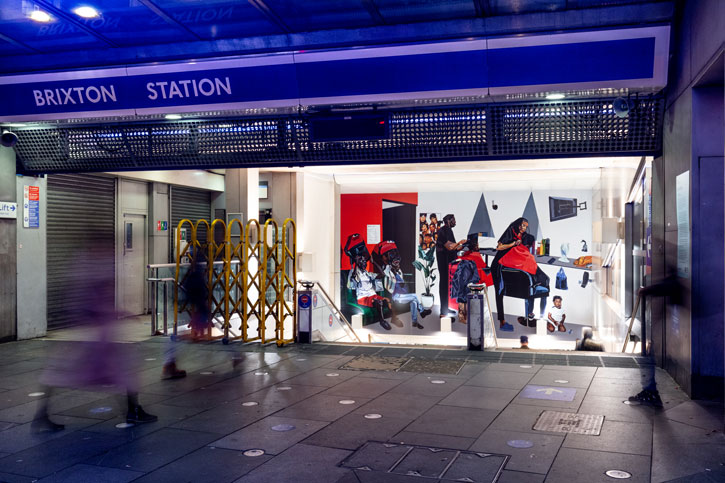
David: Did you enjoy working on such a large scale?
Joy: My original painting isn't the same size of the mural at Brixton station (that's a vinyl enlargement), but at four metres wide it's still the biggest painting I've ever made. I chose to paint it half-scale, which was a lot larger than it needed to be. I knew I wanted multiple figures, and working on that scale was the easiest way for me to make sure the composition worked. It was really enjoyable, but the large size made it difficult to time manage. It was also physically quite hard, as I was up and down a ladder a lot.
David: You have a very distinctive painting style, using flattened perspective and bold colours. The faces you paint look very sculpted and are often quite distorted, even verging on the abstract. Where did this way of working come from?
Joy: It was quite instinctive for me, but I think it really developed from using old photographs, where the lighting was a little all over the place, dividing the face up into segments. From there it's just how I see faces and is enhanced by the flat angled brushes I use.
David: What draws you to certain images?
Joy: Some are from photo albums, some from archives. Some of the figures I paint are made up from a range of sources. I might get the face from one image, and the body from another image. It depends on what facial expression or stance I need for a specific painting. The figures in my earlier works were chosen because of their facial expressions, clothing and pattern. Man Drinking Coffee (2019), for instance, is based on a photograph of my dad. I was drawn to it because of his shirt.
Enough is Enough
2020 by Joy Labinjo (b.1994) 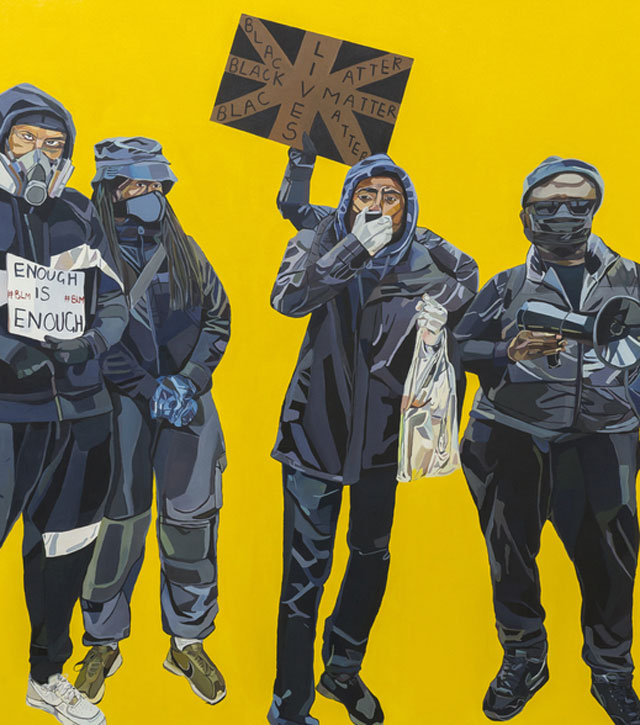
David: You are most well known for your paintings of Black families. More recently, with works such as Enough is Enough (2020), The Real Thugs of Britain (2020), and We Don't See Colour, We Don't See You (2020), your work has become more political. What led to this shift?
Joy: These works were made in response to the Black Lives Matter (BLM) movement and explore aspects of racism and colonialism in Britain. For a while I'd been thinking about ways to make work about the present. Though my previous paintings had been painted in the present, they weren't necessarily rooted in the present because they were based on photographs and archives from years ago.
The real thugs of Britain
2020 by Joy Labinjo (b.1994) 
During last year's BLM protests I felt an urgency to paint my interpretation of what I witnessed. I was at those protests and I was impressed that, even with the risk of COVID-19, thousands of people were willing to go. The legacy of colonialism was being confronted and white people were realising that racism hadn't gone anywhere. These are issues I've always found important, but those paintings have a clearer narrative. Since then, I've made other works interrogating the same themes but that look very different, for example, the recent paintings I've made of Black Edwardians such as Sarah Forbes Bonetta (2020).
Sarah Forbes Bonetta
2020 by Joy Labinjo (b.1994) 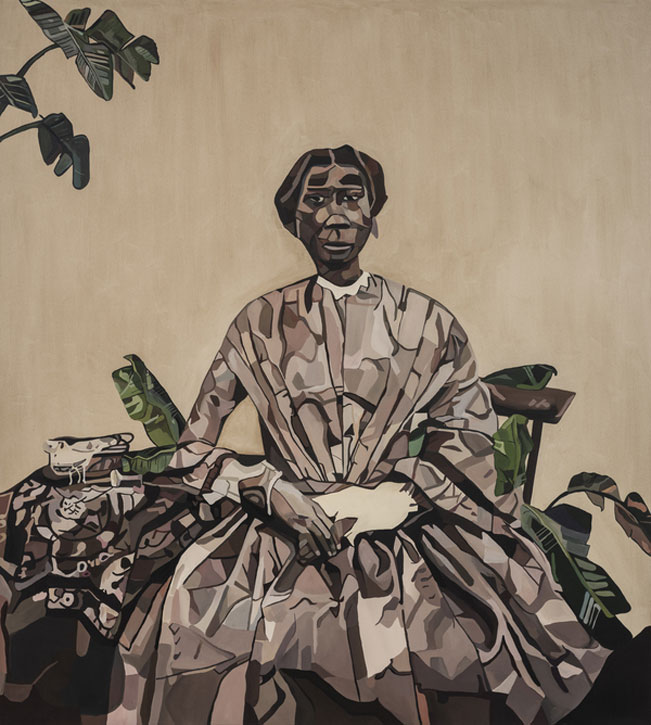
David: What advice would you give to aspiring artists?
Joy: Make the work that you want to make and that feels important to you. It might be scary, and others may not get it, but I think that's the only way you can be excited about your work and stay inspired to keep going. Secondly, it's important that you actually make things; nothing will happen if all you do is talk about what you're going to do and never actually do it. Try and carve out the time to make your work, even if it happens slowly.
David Trigg, writer, critic and art historian
Joy Labinjo's 5 more minutes, commissioned by Art on the Underground, can be viewed at Brixton Underground station until November 2022.

